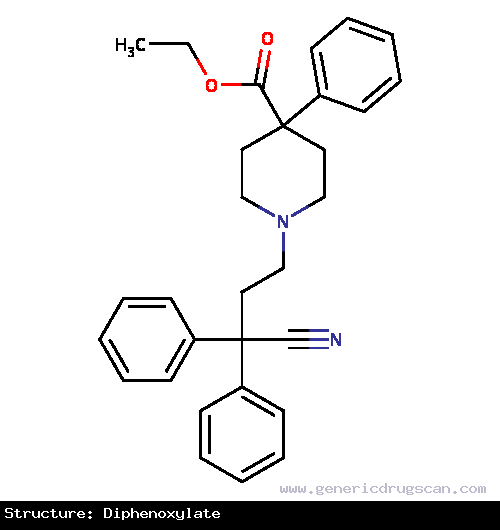Diphenoxylate Drug: Indication, Dosage, Precaution, Side Effect , Storage, Category Type and corresponding Brands - www.genericdrugscan.com
Drug Status in Canada : Approved
pronunciation
pronounced as (dye fen ox' i late)
Why is this medication prescribed?
Diphenoxylate is used along with other measures, such as replacement of lost fluids and salts in the body, to treat diarrhea. Diphenoxylate should not be given to children younger than 2 years of age. Diphenoxylate is in a class of medications called antidiarrheal agents. It works by decreasing activity of the bowel.
How should this medicine be used?
Diphenoxylate comes as a tablet and solution (liquid) to take by mouth. It is usually taken as needed up to 4 times a day. Follow the directions on your prescription label carefully, and ask your doctor or pharmacist to explain any part you do not understand. Take diphenoxylate exactly as directed. Do not take more of it or take it more often than prescribed by your doctor.
The solution comes in a container with a special dropper for measuring the dose. Ask your pharmacist if you have questions about how to measure a dose.
Your diarrhea symptoms should improve within 48 hours of treatment with diphenoxylate. Your doctor may tell you to decrease your dose as your symptoms improve. If your symptoms do not improve or if they get worse within 10 days of treatment, call your doctor.
Diphenoxylate can be habit-forming. Do not take a larger dose, take it more often, or for a longer period of time than your doctor tells you to. Atropine has been added to diphenoxylate tablets to cause unpleasant effects if this medication is taken in higher doses than recommended.
What are the precautions to be followed?
Before taking diphenoxylate,- tell your doctor and pharmacist if you are allergic to diphenoxylate, atropine, any other medications, or any of the other ingredients in diphenoxylate tablets or solution. Ask your pharmacist for a list of the ingredients.
- tell your doctor and pharmacist what other prescription and nonprescription medications, vitamins, nutritional supplements, and herbal products you are taking or plan to take. Be sure to mention any of the following: barbiturates such as phenobarbital or secobarbital (Seconal); or tranquilizers. Also tell your doctor or pharmacist if you are taking the following medications or have stopped taking them within the past two weeks: monoamine oxidase (MAO) inhibitors such as isocarboxazid (Marplan), phenelzine (Nardil), selegiline (Eldepryl, Emsam, Zelapar) or tranylcypromine (Parnate). Your doctor may need to change the doses of your medications or monitor you carefully for side effects. Many other medications may also interact with diphenoxylate, so be sure to tell your doctor about all the medications you are taking, even those that do not appear on this list.
- tell your doctor if you have jaundice (yellowing of the skin or eyes caused by liver problems); bloody diarrhea; diarrhea along with a fever, mucus in your stool, or abdominal cramps, pain, or swelling; or diarrhea that happens during or shortly after taking antibiotics. Your doctor will probably tell you not to take diphenoxylate.
- tell your doctor if you have Down syndrome (an inherited condition causing a range of developmental and physical problems), or if you have or have ever had ulcerative colitis (a condition which causes swelling and sores in the lining of the colon
- large intestine
- tell your doctor if you are pregnant, plan to become pregnant, or are breast-feeding. If you become pregnant while taking diphenoxylate, call your doctor.
- before having surgery, including dental surgery, tell the doctor or dentist that you are taking this medicine.
- you should know that this drug may make you drowsy and dizzy. Do not drive a car or operate machinery until you know how this drug affects you.
- ask your doctor about the safe use of alcoholic beverages while you are taking diphenoxylate. Alcohol can make the side effects from diphenoxylate worse.
What are possible side effects of this medication ?
Diphenoxylate may cause side effects. Tell your doctor if any of these symptoms are severe or do not go away:- nausea
- vomiting
- loss of appetite
- headache
- restlessness
- tiredness
- confusion
- changes in mood
- dryness of the skin, nose, or mouth
- numbness in arms and legs
- decreased urination
- ongoing pain that begins in the stomach area, but may spread to the back
- abdominal bloating
- fast heart beat
- shortness of breath
- hives
- rash
- itching
- swelling of the eyes, face, tongue, lips, gums, mouth, hands, feet, ankles, or lower legs
- difficulty swallowing or breathing
- hoarseness
Diphenoxylate may cause other side effects. Call your doctor if you have any unusual problems while taking this medication.
How to store the medication and dispose it of after its use later?
Keep this medication in the container it came in, tightly closed, and out of reach of children. Store it at room temperature and away from excess heat and moisture (not in the bathroom) and light.
Unneeded medications should be disposed of in special ways to ensure that pets, children, and other people cannot consume them. However, you should not flush this medication down the toilet. Instead, the best way to dispose of your medication is through a medicine take-back program.
Drug Category/Class
- Analgesics, Opioid
- Antidiarrheals
- Antiperistaltic Agents
- Alimentary Tract and Metabolism
- Antidiarrheals, Intestinal Anti-Inflammatory
- antiinfective Agents
- Antipropulsives
- Antipropulsives
| Prescribed | For as adjunctive therapy in the management of diarrhea |
| Weight : | 452.5873 |
| Structure | Diphenoxylate |
 | |
| Formula | C30H32N2O2 |
Diphenoxylate has 0 Brands listed
Search Generic Drugs alphabetically
